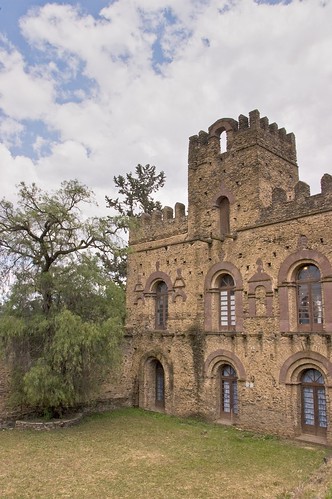Fasilidas was the emperor of Ethiopia (a hereditary position abolished in 1975) and a member of the Solomonic dynasty. That dynasty is the traditional Imperial House of Ethiopia which claims descent from King Solomon and the Queen of Sheba, who is said to have given birth to King Menelik I (the first traditional king) after her visit to Solomon in Jerusalem. Fasilidas is credited with founding Gondar in the mid-1630s. Gondar is often called the Camelot of Africa becasue of its numerous medieval castles. It is also famous for the incredible Gondarene art that graces its churches in the form of Byzantine murals -- the most famous of which is Debra Berhan Selassie.
The main castle was built in the late 1630s and early 1640s by the Emperor, who had architectural inspirations. St Mary's of Zion in Axum, Ethiopia (seen below) is another one of his architectural creations.

Fasilidas was also responsible for seven of Gondar's 40+ churches , numerous bridges, a pavilion and a sunken bathing place, which is still filled during the Timkat season with water from the nearby Qaha river. Other structures date from later periods. The grandson of Fasilidas,Iyasu the Great’s castle was described at the time by his chronicler as finer than the House of Solomon. Its inner walls were said to have been decorated with ivory, mirrors and paintings its ceiling was covered with gold-leaf and precious stones. All of which has long sine vanished from th now gutted castle.
Iyasu's most impressive achievement may be the Church of Debre Berhan Selassie, the Light of the Trinity, which is still used as a church.
While the building itself is plain, comprised of a simple thatched structure on the outside, the interior is painted with many religious and historical scenes. The ceiling is painted with more than 80 angels’ faces all. The north wall holds a depiction of the Trinity above the crucifixion. The south wall has a mural of St Mary; that of the east wall the life of Jesus; the west wall shows saints.
It is believed that Fasilidas chose this location and name based on a legend which holds that an archangel prophesied that an Ethiopian capital would be built at a place with a name that began with the letter G. This led to a number sixteenth and seventeenth century locations named, Guzara, Gorgora and Gondar. Another legend says that while Fasilidas was out hunting God told him of the place that the capital was to be built and Fasilidas followed a buffalo to the spot.
Following the assassination of Iyasu I by his son, Tekla Haimanot came a struggle for control of the imperial throne during which period no significant structures where built. Tekla Haimanot was murdered, the next successor was forcibly deposed and the next poisoned. This all stopped when Bakaffa came to the throne. He left two castles -- one attributed to him and the other to his consort, the Empress Mentewab.

Iyasu II, Bakaffa's successor is considered the last of the Emperors of Gondar to rule with full authority. During his reign, work began on new buildings outside the main palace compound as well as a city on the hills to the north-west of the city center known as Kweskwam.
Gondar remained the capital until 1855. The city was a center of religious learning and art. Painting and music, dance and poetry, together with skilled instruction in these and many other disciplines, thrived for more than 200 years. At the end of the eighteenth century a poet wrote:
Beautiful from its beginnings, Gondar, hope of the wretched!
And hope of the Great, Gondar without measure or bounds!
0 dove of John, Gondar, generous-hearted, mother!
Gondar, never bowed by affliction!
Gondar with its merry name!
Gondar, seat of prosperity and of savoury food!
Gondar, dwelling of King Iyasu and of mighty Bakaffa!
Gondar, which emulated the City of David, the land of Salem!
She will be a myth unto eternity!





No comments:
Post a Comment